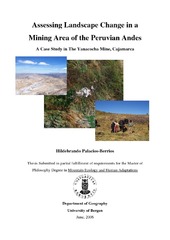Assessing Landscape Change in a Mining Area of the Peruvian Andes. A Case Study in The Yanacocha Mine, Cajamarca
Master thesis

View/
Date
2006Metadata
Show full item recordCollections
- Department of Geography [634]
Abstract
This study examines physical and perceived landscape change in a mining area innorthern Peru. Mining conflicts between companies and local people have intensified;this highlights the necessity of a better understanding of environmental and socialconsequences of mining activities. Landscape studies could be relevant to understandsuch problematic. I aim to assess the landscape change in a mining area by (1)mapping the physical landscape change and (2) surveying the local landscapepeople’s perception of the physical landscape change. I approach the materialdimension through spatial-regional interpretation of diachronic aerial-photos toproduce Land cover-Land use maps and to allow further temporal comparisontowards change detection in a GIS environment. The mental dimension was surveyedthrough the analysis of semi-structured interviews of the people who were living inthe area of the mine and who lives now on its surroundings. The material landscapeanalysis shows a change rate of 75% in seven years (1993-2000) in the whole studyarea; and of 52% in areas outside the mining facilities. This is mainly from theconversion of seminatural grassland into mining and sparse grassland. These resultscorrelated positively with local people’s perception of environmental transformations,as the dramatic reduction of basic livelihood resources such as grassland and water.Most informants report loss of practices, customs and identity. The study providesempirical and theoretical support to approaches combining GIS mapping andperception surveys in the study of landscape change.
Publisher
The University of BergenCopyright
The authorCopyright the author. All rights reserved